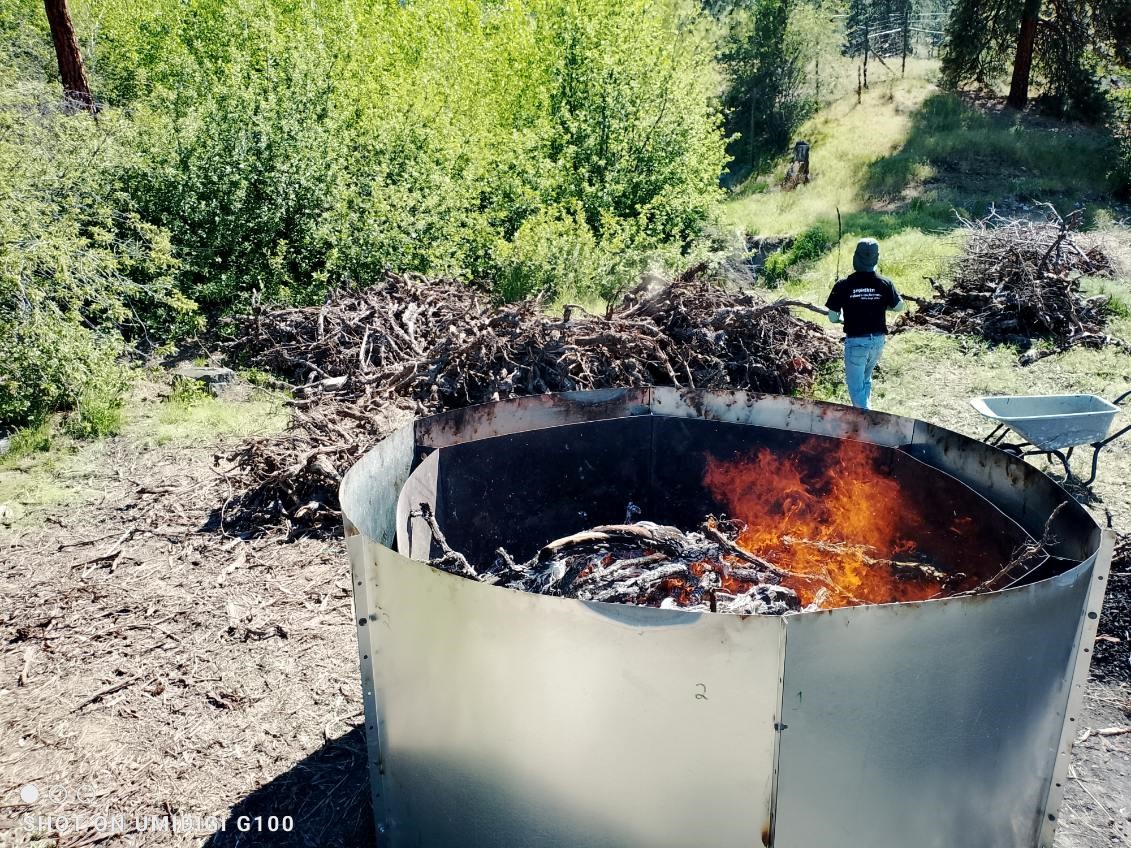Nope, not referring to oil discovery, but to biochar…
Biochar is the end product of a process used to reduce organic waste. In our case, the waste is the dead vines that we had to pull out this year as a result of a one-in-50-year event in January 2024 which saw temperatures plunge to below 25 celsius and stay there for hours.
This can be done in a closed kiln, but we had access to a Kontiki Kiln. A fledging company in Kelowna, RegenerativeBio, has made this kiln, and we offered to host a demonstration for our neighbor growers on the Naramata Bench. The kiln is made from sheet metal pieced together into two nested cylinders, creating the inner burn chamber, and an outer space of about 3 inches for air flow. The inner chamber sits on the ground while the outer one is about 5 inches higher, creating an opening for air flow.
The burn is started at the bottom of the inner chamber, and the dead vines are continuously fed into the top. Air is pulled into the space between the two walls and channeled to the top to feed the flames. This creates a smokeless burn which produces char rather than ash. The material in the bottom of the kiln is starved for oxygen, so does not continue to burn.
Once the burn is completed, either because the fuel has run out, or because the space in the kiln has run out, the fire is doused. The kiln is quickly disassembled and the char is continuously watered-down while being raked. It is important to put out every bit of fire, or the char will burn down to ash and become worthless.
At this point it appears as black chunks—like what some folks might expect to find in their Christmas stockings. It then needs to be crushed, easily achieved by placing a sheet of plywood over the pile and repeatedly driving over with a tractor or forklift, until it looks like coffee grounds.
Biochar, it turns out, is incredible stuff. It greatly improves the water holding capacity of the soil, aids in nutrient availability to the soil, Promotes the soil micro-biome and raises the much-needed carbon level in the soil. Also, it is the only substance found so far to effectively remove microplastics from water. Uber-savvy home gardeners also know it is very dear—a 20 liter pail sells at garden stores for $200!
Our demonstration was well-received, with Naramata Bench growers, folks from the Lake Country MLA’s office, and home gardeners in attendance. The Penticton Fire Department was super supportive, as this is a controlled burn, producing no ash to threaten the surrounding area. We were able to reduce our waste pile by about a third, and then finished it off with two subsequent burns.
Biochar cannot be applied directly to the soil as it is light and would be blown away. We prefer not to dig it into the vine row as we don’t want to disturb the soil microbiome. (Most BC vineyards are “no-till”, a source of pride for our local viticulture scientists.) Ideally it should be mixed with compost and applied, or used to make a tea which can be sprayed on.
Biochar has been used for decades, if not centuries in Italy, and much of the information RegenerativeBio has acquired has come from the Chianti area of Tuscany. Here is a presentation regarding this workshop: https://www.bcwgc.org/videos/october-17-2024-bcwgc-rd-committee-meeting
The AAFC Summerland Research and Development Center is currently studying biochar as part of a vineyard and orchard groundcover research project, and the principal scientist stopped by to have a look and request samples. Our biochar is somewhat unique as the fuel is a single source, and will not contain any contaminants which could be present if using treated wood, etc.
Our vineyard manager and I are researching best practices before we come up with a plan to use this precious material. Stay tuned, the best is yet to come!
